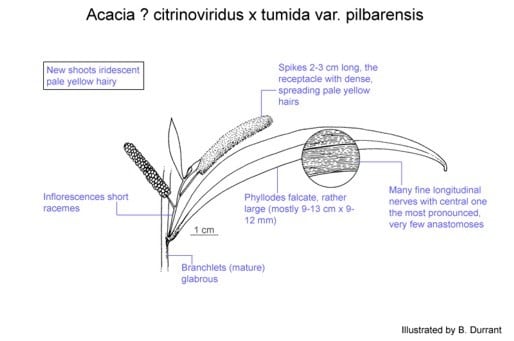Acacia citrinoviridis Tindale & Maslin x Acacia tumida var. pilbarensis M.W.McDonald
WATTLE
Acacias of Australia
Family
Fabaceae
Distribution
Known from only a single collection near Cane River Stn, c. 80 km SE of Onslow, north-western W.A.
Description
Tree to 3 m high, the canopy dense and spreading. Bark dark grey. Branchlets glabrous. New shoots sericeous with dense, iridescent, citron yellow hairs which soon age silvery white. Phyllodes narrowly elliptic, falcate, acute to acuminate, 9–13 cm long, 9–12 (–15) mm wide, thinly coriaceous, sericeous when young, aging glabrous; longitudinal nerves numerous, fine and close together, very few anastomosing, the central nerve more pronounced than the rest, marginal nerves discrete, narrow and yellow. Inflorescences mostly short racemes 5–15 mm long, the axes densely silvery sericeous and normally growing out; spikes 20–30 mm long, the flowers densely arranged; peduncles 5–10 mm long, densely sericeous, hairs white; receptacle with dense, pale yellow, soft, spreading hairs. Flowers 5-merous; sepals ±free. Pods unknown.
Habitat
The plant grew in hard, red clay along a watercourse on a recently burnt spinifex plain.
Specimens
W.A.: TV repeater tower on gas pipeline, 2 km SW of Mt Stuart rd, 15 km W of Cane River Stn, 80 km SE of Onslow, D.J.Edinger 1584 (PERTH).
Notes
The hybrid status of this entity is based on morphological criteria; field study and further collections are needed to confirm its taxonomic status. It resembles A. citrinoviridis in most characters except that its inflorescences are arranged in racemes, which is characteristic of A. tumida var. pilbarensis. It is not known if the putative parents occur where this plant was found, however they do occur within the same general area but are not particularly common. For further information see B.R.Maslin et al., Wattles of the Pilbara CD-ROM (2010).
FOA Reference
Flora of Australia Project
Author
B.R.Maslin
This identification key and fact sheets are available as a mobile application:
URL: https://apps.lucidcentral.org/wattle/
© Copyright 2018. All rights reserved.






